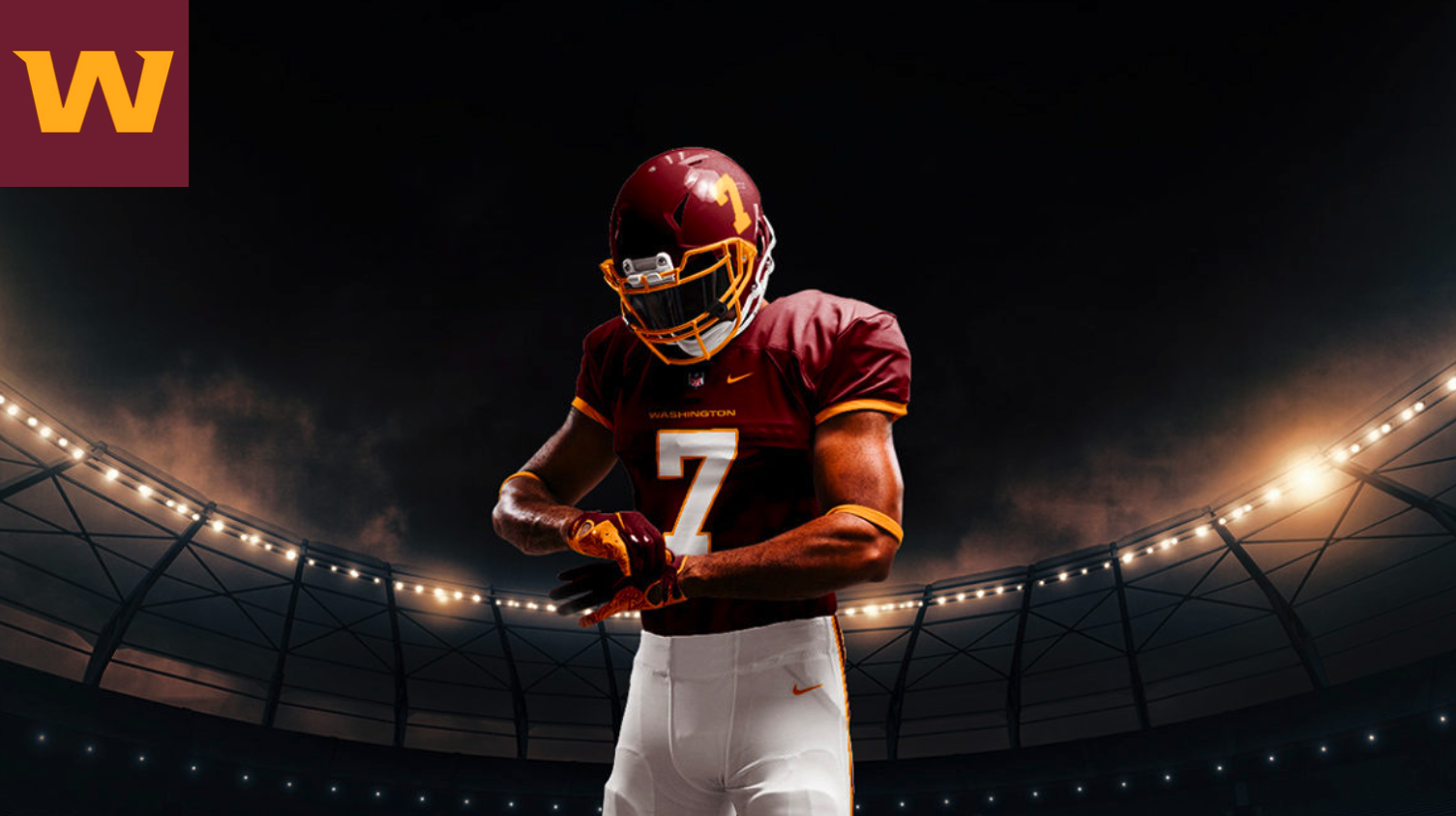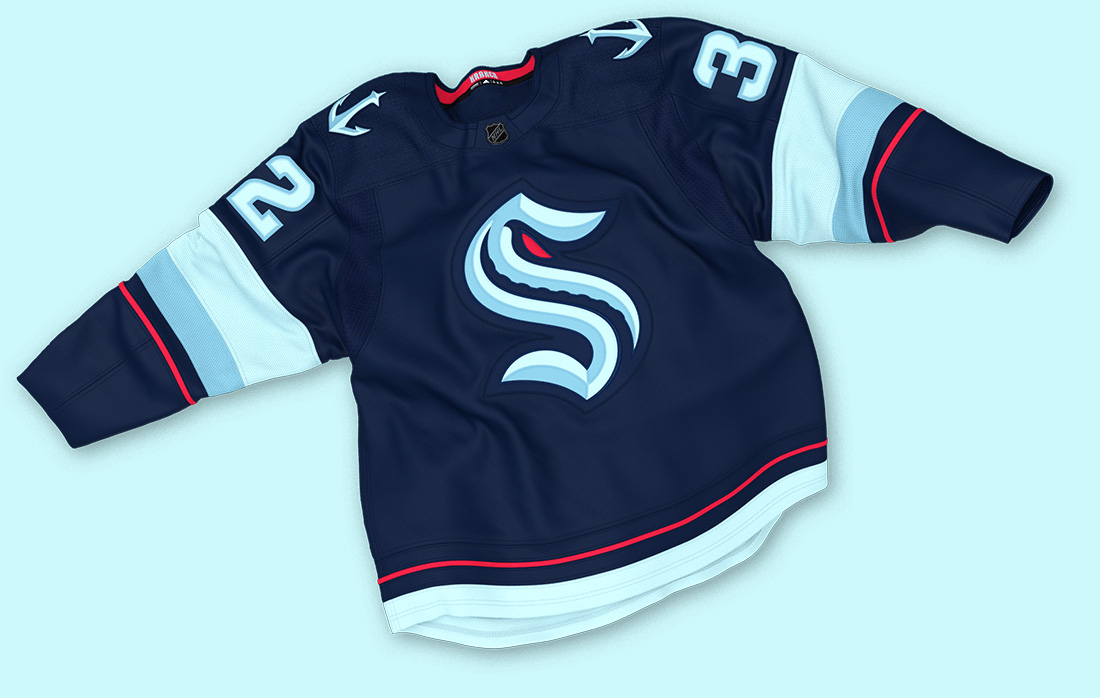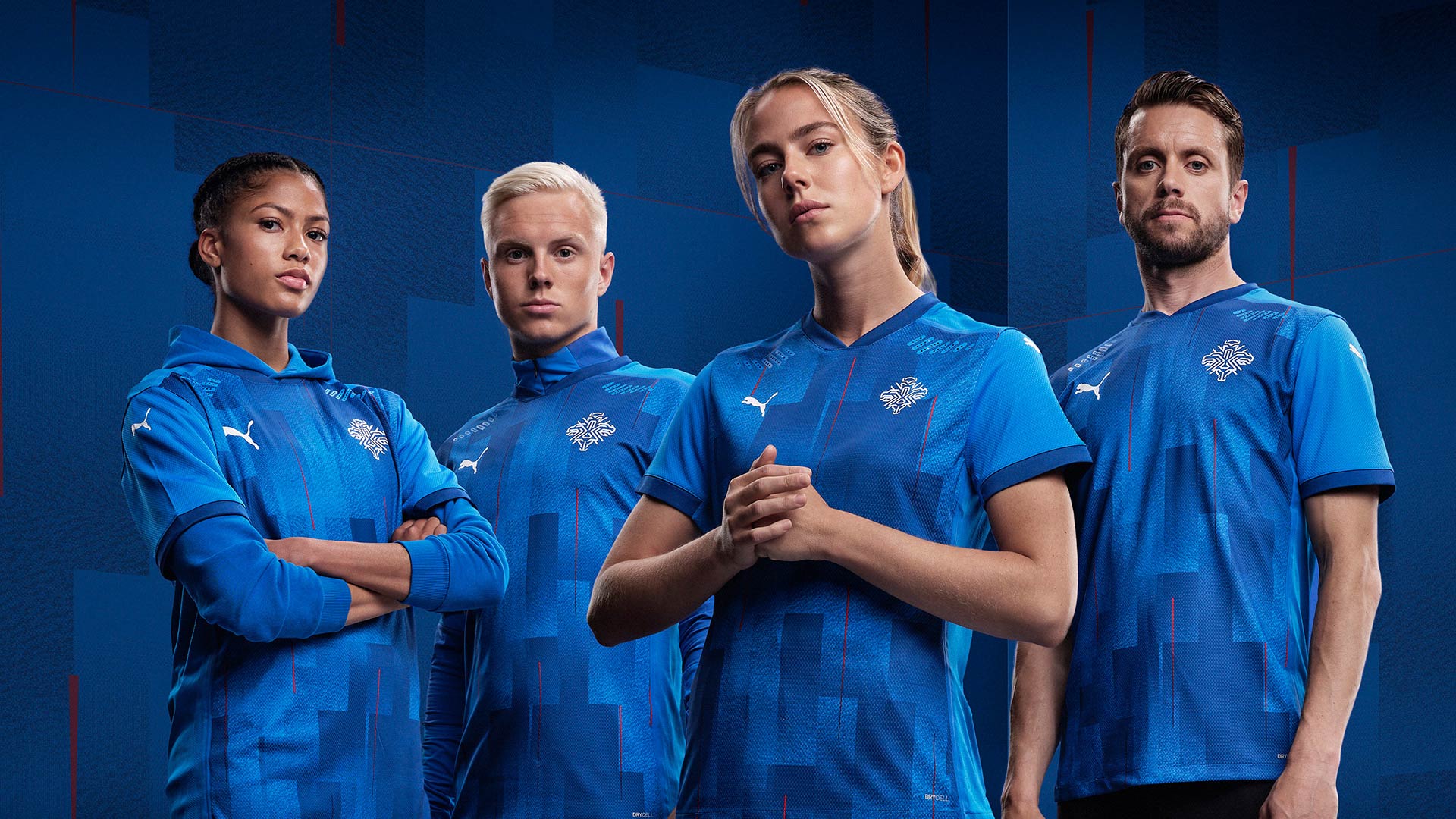Resources & Presentations
Sports Team Branding: 5 Identity Breakdowns

There have been a number of high-profile rebrands or brand launches recently in the sports world. What are the branding implications of these launches and visual identities? What strategic decisions and research are involved in the branding process?
We discuss the launches of the following:
- Washington Football Team [NFL] 🏈
- Seattle Kraken [NHL] 🏒
- Racing Louisville FC [NWSL] ⚽️
- Charlotte FC [MLS] ⚽️
- Iceland National Team [FIFA] ⚽️
Why is a cohesive visual identity important for brands in sports or business? We break it all down!
**Spoiler**
Here's what Director of Brand Experience, Cynthia, thought about the Iceland rebrand 😉

*This transcript has been edited and formatted for readability.
Washington Redskins Rebrand as 'Washington Football Team'

Kyle Smith: Let's start with the Redskins. In response to public pressure to change the name, they recently announced that they'll play the 2020 season as Washington Football Team. What do you think about this approach and what they've done?
Bo Bothe: I think there are three components to this. One, there's the actual change that they're making, the 'why' which should be something that's considered anytime you do a brand identity, or especially a change.
The second is this interim step that they're taking, which is the Washington Football Team. I know in a lot of the circles that I've listened to and on a lot of the sports talk radio, this decision is taking a pretty good beating, I think even LeBron weighed in on it.
Just waking back up from my pregame nap to see about The Washington Football team??? 🤣🤣🤣🤣🤣🤣. Is that real?? No way! Oh man they had a thorough intense long board meeting about that one huh. 🥴🤦🏾♂️
— LeBron James (@KingJames) July 23, 2020
But the reality is, it's actually not a bad approach. It's an effective way to really capture the affinity to the city that they're in, and then jump into whatever an identity is or a mascot would be in the future. As opposed to sticking with a mascot that, right now, is cultural dynamite, and has been an issue for years for them. Watching them struggle with it has been a challenge.
There are these two components that are interesting, they have to make a change and they really need to do it now, but then the idea of having this interim step, which is, I think, pretty thoughtful in associating it with the city that they're actually representing because that's where you want people to love you anyway.
And then third, keeping the colors, which, from an affinity standpoint, makes the most sense. So, there are a lot of nice things, but that gives them time to then really think through making a change because they were adamant that that was not going to happen for a long time, and obviously it's not going to be able to stick anymore.
Cynthia Stipeche: Agreed. I think the nice part about using this current solution is that it gives them time to really think through strategically how they want to approach their brand going forward, versus it just being willy-nilly and just like, "Okay, this works."
Because when you think about sports, this is people's lives and culture, near and dear to their hearts, things that they're passionate about. So you can't take that lightly, and it's a good response. It's something that probably could have been dealt with earlier. It wasn't, but now to take a little bit of time to think about it, it's a good move.
Britany Ponvelle: Yeah, I would agree. Once they made the announcement, if they were reactive and hastily tried to pick a new name, I think they could have definitely risked alienating a lot of their fans – people who both wanted the name to stay and also people who wanted it to be changed. They could have lost all of them, so I think it is a good move, too. Of course, take the time and change it intentfully and do the research and make sure that it reflects the values of the city and the people and what they love about the sport.
Kyle: If you had to guess, behind the scenes, what is going on, what are they strategically thinking about, what are the questions that they're asking as they go through this process to look at introducing a new identity?
Bo: They're probably thinking, "Okay, are we going to lose equity? What could we gain by doing this?"
Good will on all sides. The challenge in today's world is everything's so 50/50, where you have people that fall on one side of the issue or the other side of the issue. If it gets to 60/40, that's amazing. So, 50% of your audience is going to be upset with the change, 50% of the audience is going to be happy with the change. There's probably a 20% piece of this audience right now that's thinking, "Okay, while I'm not happy in losing my old Redskins that I grew up with, this has to change."
And so this is the right time, you have to do it now. To Cynthia's point, it probably should have happened years ago. I'm a nostalgic sports guy, so I don't take this stuff lightly at all.
But the reality is, this is the time to do it. And I think they're thinking about are they going to lose some opportunity, but also what opportunities can they gain? Can they tap into something in their past that's even better? Can they grab this period of time in history and really build an affinity for them that they didn't have before? There are all kinds of things that they should be asking.
Cynthia: I think we're at this transformative moment culturally within the country. But also when you think about demographics, people who are possibly aging out, and I'm talking about people who have financial implications here, people who have money, and the disposable income, the ability to invest in watching sports and everything else, it's changing.
So, you have to look at this younger demographic and how they communicate with brands. It's not just a passive audience that just sits there in front of the television set and watches stuff, these are people who want to engage with a team and want to engage with a brand.
So, if there was ever a moment beyond just cultural issues to reimagine your brand as a team, now's the time to do it. It's amazing. So, they can be there at the forefront, and instead of looking at this like, "Did we succumb to certain groups of people?" This is a great opportunity, grab it and go. Do something new.
Britany: Yeah, I do think that's a question that they are definitely having to face is: do we play it safe and go somewhere that feels close to where we are, but a subtle evolution of it, or do we change it completely? Which is a big question. It would be really interesting to see what it would look like if they did change it completely because I think if they were to be timid and play it safe and change it subtly, you just risk looking like you are not doing it with heart or just succumbing to the pressure that people have put on you.
But by being bold and going out there, I think you could win the hearts of the people who didn't want it to change and the people who do want it to change, as long as it really speaks to capturing the essence of the city and the passion of the fans. If they could do it that way, then I think they'll be successful.
Cynthia: It could be something so much richer than it's ever been.
Bo: I think, to that point, even if there is a percentage of people that are like, "You're going to take this hat out of my cold, dead hands." But the reality is 100% of the people get it. Not 100% of the people agree, but 100% of the people get it.
This might be the only time that that brand could make this shift with almost no repercussion. There's going to be blowback, there's going to be, "I can't believe Daniel Snyder held onto it for as long as he did" and "Why did they do that for so long?"
But the reality to it, Kyle, to Cynthia's point and what Britany was just talking about, this is the time. With the changes in culture, with the way people interact with the brands, with the way that they share information and talk about things, with their association, you don't want to be the guy on Twitter that's getting beat up because you have a Redskins logo on your Twitter feed.
That's all part of it. Right or wrong, good or bad, whatever your belief is – this is the time. If they're going to make this change, now's the time to do it.
Kyle: Where does brand research or customer research come into play when making decisions like this? Because, Bo, you pointed out they have equity, they have all their fans who have this affinity for the colors and this team and this name, and it's going to be difficult to change their minds.
It seems like there's not going to be one approach that's going to make everyone happy, but is a quantitative piece to this important and why?
Bo: Honestly, I don't know that quantitative matters here, and that's going to sound really strange. It's not like research doesn't matter; they've got all the data about what colors people buy and all that kind of stuff. But this is passion, this is Washington Redskins fans' passion. How do you measure that? It's going to be all over the place, it's going to be all different kinds of depths, it's going to be tied to losses and wins, and things that happened and who I watched it with when I was 12-years-old.
It's not measurable.
When it comes to that kind of thing, it's immeasurable, the value that it holds in someone's heart. You being a Cleveland fan, me being a Houston fan, it's all bound up in watching the Oilers blow it against Buffalo, and watching that with my dad and watching that for the first time, or watching the Oilers for the first time with my wife at the house during Christmas. All that stuff is not measurable, to the point of making a decision like this.
Cynthia: That's a very good point, Bo, because sports, it's moving away from what I think you would traditionally analyze with a commercial brand. It's on par for some people close probably to religion because people are so committed and so passionate, and there's so much emotion rolled into teams and brands.
Folks who are committed fans of their hometown, where they may have not won a World Series ever, or not for very long, and people keep on going; the football teams where it's just nothing but heartbreak, but that's a part of our culture, dealing with a heartbreak, or wins.
But how do you measure that?
Britany: I think more of the qualitative, like we do voice-of-customer research for some of the brands that we work on – I think that's where the real color and meaning would come out is hearing the stories of the people who love the Redskins and what they've loved about the brand historically, what they love about Washington and just that general area. A lot of that could add meaning to a new logo for them.
Release the Kraken! Seattle Announces Launch of Newest NHL Franchise
Kyle: So, we started on the East Coast, and I want to take us West now. In the hockey world, the identity of the newest NHL franchise was announced as the Seattle Kraken. It was actually announced, I think last week, that they are now the NHL's best-selling expansion identity launch ever. So, it's clearly resonated with people. But from the colors to the logos to the typography, what do you think about their visual identity?
Cynthia: Well, one, who doesn't love an octopus, especially a kraken?
Britany: I know. And the way you said that, Kyle, that's already passion, we know what you think.
Kyle: My jersey's on the way!
Cynthia: As a designer, it's really an awesome-looking brand. It just looks cool. But, also, it's got this nice modern feel to it. Having lived in Seattle for a little while, there's little snippets in there that I notice in there, like with the Space Needle in there, which ties it back into the local area, the city, and just it being by the water.
It's cool and it speaks to that area. I'm not sure about the actual fans, if they're like, "Yes, Krakens!" But if you have to latch on an animal to a waterside city, why not a kraken?

Bo: It follows a lot of the blues. I mean the same thing that the Mariners have always had, the same thing that the Seahawks have had. I didn't think about that in our prep, but it's like, oh okay, it's sea mist and blue. Wait, the Seahawks are blue and green. And the Mariners are blue and green. It's like, okay, there's a familial thing going on here. Okay, that's cool.
The one thing, when Cynthia said, "Go Kraken!" That's the one thing in our prep that we didn't even consider. Because we looked at the identity, and, separate, the design is beautiful, it's very well-executed, it's done well; to Cynthia's point, there's an anchor icon that they use that has the Space Needle in it. There's some really nice pieces to this, the red eye in the S, it makes a great icon for a hat, I mean I almost want to buy the hat. I haven't seen it yet, but what does it look like? I do think, man, Go Kraken.
Go Astros. Go Oilers. Go Texans. Go Kraken. I mean it'll work. Go Mariners. I hadn't thought about the audiology of it, I mean the sound part of it, which is something that you should consider.
That's one of the challenges. It's like, "Go Washington. We are the Washingtons." So, there is the how-it-sounds when you say it, and I think it's an important part of sports branding or any kind of branding activity. We do this with naming. When we do naming, it's the same thing, it's like, "How is that going to roll off the tongue? Is it easy to say? Does it make me feel good when it comes out of my mouth?"
Britany:
The system is just so smart and it has so many layers to the story. No matter why you love Seattle, I feel like you would probably have a reason to love that logo because they cleverly worked in a lot of different layers there with the kraken, but also a vessel. The ship with the S is beveled to look like a ship, all the way to the tentacle in the negative space, which hits on the kraken, with the little eye there.
I mean they work in a lot of layers to that story. It looks so good, I mean it's just a great brand. And I think, when we were talking about heritage before, why it could have so much richness, just digging into the heart of the city and trying to bring that out, because people are there for a reason, so play with that.
Kyle: Yeah, I think they did a great job with that. To your point, Bo, geographically, it's like a family, even the soccer team, the Sounders, is a green and blue. I didn't even think about that, but it's clearly meant to tie into, all those four teams to connect in some way, which is really, really cool.
The Latest NWSL Expansion Team: Racing Louisville FC
Kyle: Shifting gears a little bit to soccer. I want to take a look at the identity that did get a lot of buzz recently in the NWSL, so the Women's Professional Soccer League of Racing Louisville FC. And this was a recent launch. I'd love to break that one down. What did you think about their identity and their approach?
Britany: Personally, I did not think it was very interesting, but it technically works. I was reading a little bit about this, they had a press release. Basically, they asked their fans, "What do you want this to say? How do you want this to feel?" And what they wanted to do with the logo was tie it into the city, kind of like what we were saying with the other teams, which is purple and fleur de lis, and they nailed that.
That's exactly what ties them, I think, visually, the way they see Louisville. There's a lot of visual similarities there. It ties into the other teams in the city. I felt like the execution just felt a little lazy, honestly. But it works, it's not a bad logo.
Cynthia: Yeah, I agree with you, Britany. Looking at it, I'm like, "They probably could have done so much more with it." I look at it and I'm like, "Great first pass, now push it." I'm also like, "I've had enough of the X thing on logos." It gets overused all the time.
Bo: Yep. Thinking through football club identities and logos and, Kyle, you kicked a couple out when we were doing prep, but this one, it wants to fall in line with the whole crest idea, and it's nice, but then you have to start to think. And, again, I'm not a huge European football fan, so I'm going to fall to the Saints, and so if this is a U.S. soccer team, back to brand equity, who owns the fleur de lis? While it makes perfect sense for Louisville, we're talking French, it's Louisville, there's been years of equity built up in that fleur de lis for the Saints that it's hard.
Now that Louisville uses it, it shows up in their identity, but then when you try and add horse racing to soccer, it just doesn't ... there's a lot going on.
Back to Cynthia's point, could you have conceptualized this a little bit differently? Because you don't want to refer to a soccer team as a bunch of horses. There are just all kinds of problems with this that I see could happen. And so to Britany's point and to Cynthia's point, I think they had to dumb it down a little bit.
They made something very simple super complex, both from a design standpoint, and then adding the idea of racing into Louisville with the football club, with the crest, with the fleur de lis. It's a cacophony of visual and verbal pieces.
The color is great and the color works really nicely. It's just, to Cynthia's point, there's a lot going on in that very simple logo that oversimplified. It's weird. I'm having a hard time with it.
Cynthia: I agree. It feels a little bit like possibly designed by committee. It's just too much.
Kyle: Well, they did do a unique launch video where they actually offer the explanation of the colors and all the individual pieces that ended up making the logo, which I thought was a really effective and interesting approach to roll this out and connect on that level with the city itself. So they're explaining why they made these decisions in the process, even if maybe they missed the mark a little bit.
Bo: But I think, Kyle, one thing, I don't know about you guys, but in design school: if you've got to explain it, then it missed.
When we present brand identities, my style of presentation is typically option 1, 2, and 3 ... thoughts? If it doesn't strike them right off the bat and you have to explain it, is there something in the way of the communication that's needing to happen?
When you pull it all the way back to the Redskins, the general idea of the person that picked that brand identity was "fierce, rough, fight-you-till-the-end, this-is-what-we-want-to-be-known-for." Now, whether it was done in a stereotypical or racist way is another story. But that's what they were trying to capture.
So, with this, are we trying to capture the feel of the club? Are we just trying to capture the feel of the city and hope that everybody gets behind it? It doesn't give the club an identity.
Right now, it's just a bunch of Louisville stuff put on a purple circle.
Bo: At that point, it's great, this club then will have to establish what it means. And what people are trying to do, like the Texans and the bull, or the Jaguars, they want to be fast and rugged and rough, or they want to be quick, there's that thing. But the benefit to this is it's a blank canvas for this team, too, they can establish any style and it doesn't get weird.
Cynthia: Usually, when we develop marks, we want to make sure that it works, it can be deconstructed and you can still look at it and understand who they are. This logo, everything's locked in together, I can't pull this apart. Some logos are like that. Another test for this is: does it work large-scale? Does it work very small? So, even from little things like that, little technical perspective like that, I don't know how far down I can shrink this down, then the name, everything gets super tiny. That's on the practical side.
The MLS Goes to Carolina: Charlotte F.C. Launch
Kyle: I think this is a unique challenge for soccer clubs in developing identities because there's so much precedent and influence from across the pond, and we're trying to get up-to-speed here and play into what is at the heart of American sport identities, which is vastly different than what people connect with on an international level. So, there's this tension all the time in do we play to a system that is much more international/European? This has been this way for decades. Or do we try and integrate that with the American sports landscape? It's definitely a tension that NWSL has felt and MLS, which leads me into the next one that I want us to cover, and that's Charlotte FC.
MLS, they actually have a position dedicated to brand development at the MLS because their goal is to continue to expand the league. So, his name's David Bruce and he, in an interview recently, said, "For us to be successful, we have to carve out what is right for the local marketplace to lean into and what makes that city special." So, that goes back to a little bit of what we were just talking about with Louisville, wanting to connect with the locality where they're based, which seems to be a good strategy because it's about managing perception in your local community.
But he also said, "We look at other sports leagues and then try and do the polar opposite," which, again, is this tension of do they cater to precedent from European leagues and international leagues, or try and integrate into the American sports landscape? What do you think about this recent launch? Does it reflect that approach to be different? Does it stand out in any way?
Cynthia: Well, is it groundbreaking? It feels a little bit like it's another button with tiny type and something in the middle. And as far as it being unique specifically to that city, to Charlotte, I'm not sure if a crown is ... we see crowns everywhere. I don't know, it'd be interesting to see what the reaction was from the fan base.
Britany: I read a little bit about this one, too. They're trying to say a lot with this, and I think the story beneath it and what they were trying to say is interesting, like they also try to hit on the heritage of the city being the Queen City. So, the crown is there for that, so that makes sense. I know the circle shape was supposed to represent a coin because of it being a financial capital.
When you read the story beneath it, I see why they made some of the design decisions that they did. However, when you look at it, it looks like a circle badge, and none of that rich heritage and story tied to the region really comes through for me.
Also, I get BMW at a glance, too, which is high-end, so I don't know if that was a tone they were going for, something that feels high-end or elegant. I didn't really read that with the story that they were trying to communicate. In summary, I think it has really great meaning behind it, but I feel like they didn't do the best job at hitting that emotion and communicating that story behind it.
Cynthia: I was just going to say, even if you go with a crown, there's probably a million just different ways you could work with that crown shape, or you could treat it typographically. Go all out, do something that's really garish, just something.
Bo: What are you trying to achieve? Again, the idea of a crest and the shields and the different things that were developed 100 years ago when soccer clubs started playing, that's great and all, but in today's world, like we're talking about with the Redskins, with social media and how gear and things have become more fashion statements and different things like that, you have to take that into consideration. So that crest needs to be pretty awesome.
The Colorado Rockies, that was always just a disaster, that logo with the CR on the hat. You can't put a C because of the Cubs, right? And you could put an R, maybe. I think the problem is when they lock up the CR, those two letter forms just don't work together. It's always looked horrible; the designer in me just cringes every time I see one of their hats.
When you look at the CLT thing, it's the same, they've tried to jam these different things in it and it's just not working. I hate critiquing design because I don't know everything that went into it, but if the stated goal of the MLS is to develop identities that are edgy and taking the best of all different worlds, this one didn't do that. Overused crown, tiny type, trying to put different things, wrapping it into what would be a seal, and then jam "Football Club" on there. Come on, man.
To your point, I don't really care about the kraken, but I kind of want a hat, I mean they're pretty cool. And I don't do that lightly, I only wear hats for teams that I cheer for. That's the emotion you want it to affect, and this doesn't do that.
The people in Charlotte will be excited about it, they'll wear the gear, they'll buy the stuff, but I don't know how fired up they're going to be to wear it out at night, unless they're winning; winning changes everything, this logo means a lot more if they win.
Cynthia: And I think another thing, too, is differentiation, because if you've got 15, 30, 100 teams out there and everybody's got this seal, they all start looking the same. So, the differentiation is missing, so I might mistake my home team for Charlotte, versus if we've got something that's a really strong identity, a really strong brand and they speak a certain way, everything that ties into that local community and the culture. Then you have something special.
Four Guardians, One Identity. Iceland National Soccer Team Rebrand.
Kyle: Now I want to take us across the pond to Iceland and their rebrand of their National Soccer Team that got a lot of positive reception. Break down their approach to me. This is something completely different, it's not that typical crest that they went with. What do you think about what they did?
Bo: There's the kraken and then this is a close second.
Britany: I know, I would love to see them go head-to-head.
Cynthia: Going back, all the things we've talked about, the paths, culture, the people, brands that tell the story about the place where they come from, their origin, and just this cleanliness, it tells a story about that team. Oh my gosh, this logo has it all. Anyway, I could just go on and on about this.
Bo: It gives them a lot of different elements to pull out, the main icon is a giant, and a bull, and dragons – it taps into both the spirit of the land and it's executed in a way that every time you look at it, you see something different. But it holds together enough to where it's like, "Okay, that's Iceland Football Club," bang, that's easy to see. It's a really nice thing.
It works, it absolutely works, where you can see a stadium of people with different iconography, all relating to their heritage, that all feels the same. The whole execution. I mean, gosh, the water bottles are even cool. It's a really nice execution.

Cynthia: Which goes back to this whole thing when we were looking at these button-type or badge-type logos, where it has to be together for it to work, and this is a great example of the mark itself is a system that can be pulled apart and it still retains its strength as a total brand. It won't fall apart from that. So, that, in my mind, is just a really smart mark and brand.
Britany: And it's like a modern evolution of a crest, too. It doesn't always have to be a seal and a circle to feel like a family crest, and I think that's a part of the story that they wanted to tell. Something that showed their unity as a team and as a country. So working in a modern crest idea, I think, is really smart.
Just the way they were able to work in the four Icelandic guardians, I have so much respect for the way that was drawn because it's really hard to make things out of lines, especially only two angles of lines, and they were able to represent four different characters there.
And it has this distinct mood to it when you look at it, too – which I think is some of the reactions that we had to the other logos that we looked at – you didn't get a mood when you looked at it, you had to work to figure out what it meant. Here, even though, off-the-bat, if you don't know that they have four guardians, you still have a sense of who they are from a passion standpoint, and I think that's powerful and that's still communicating in some way. And I love the weird dagger typeface, too, it's very runic and ancient feel. There's ice shards. I mean, oh my God, it's so good. It's all over the place, but it really works somehow.
Bo: Yeah, they're coming to get you. They're absolutely coming to get you.
Cynthia: Which is cool. It's rugged, but very elegant all at the same time, it's a nice balance. And it's got that X in there, but it's integrated with all of the lines. Anyway, really nice mark, nice brand.
Kyle: And it tells that story. The brand launch video is something else, if you haven't had a chance to watch it, it makes you want to go run through a wall, actually. It talks about their heritage and the four different symbols that they've integrated into this one mark. It's a story and it's cohesive and it's authentic. I have no connection to Iceland, but I felt a connection in some way to the story that they were telling.
Bo: You tapped into something there, Kyle, authenticity. A logo needs to tell a story, an identity needs to tell a story quickly, it needs to have some sort of differentiation, to Cynthia's point, it just can't look like everything else. It can be the same kind of icon, it can be a crown, but does that crown look completely different than any other crown we've seen? But then there's this authenticity piece.
And I think all of these, the great thing is when you watch their videos and you think about their brand and stuff, they are authentic to the area, but the execution isn't authentic to the need in all cases. It's not just they're Charlotte, they're a Charlotte sports team that needs to be known for something. It's not just the Icelandic Football Club, they represent the whole country, and they want to be known for something. Which is the country that's bright orange?
Kyle: The Netherlands.
Bo: Netherlands. The color itself fits them. I mean they play a fast, fast, fast game; a smart game, quick soccer. That orange, streaking up and down the field, just that color alone fits them. There are those kinds of things that you think about a little bit.
And sometimes it's hard for style because you don't know, a new manager may come in or somebody may come in and change that, but that's always part of it, that's a little bit of it: what kind of style do we plan on playing? What kind of feel do we want? What kind of feel is the city? I mean when the Oilers were the Oilers, it was like a tough, hardworking ... and the people on the team were hard-living cowboys, and it all fit, the whole identity fit. When all that comes together and then the team performs, that starts to really build the brand over time. But this captures the culture and the type of thing it's trying to communicate, which is excellence in athletics, so well.
The Importance of a Cohesive Visual Identity
Kyle: So, we'll end on this: a brand is more than a logo, but why is it important for businesses, sports or otherwise, to have a cohesive and authentic visual identity?
Bo: I think consistency ... I think there are a couple pieces. One, it needs to be authentic, it needs to represent the city that they represent, or at least a feeling or a region, there's a piece to that on the sports side of things. Same kind of thing from a corporate standpoint, a brand should represent that company's core values. Everybody's got a mission statement, the brand that's developed should represent that. And then it comes down to differentiation, execution, how should all of those things feel. And then there's the tactical, back to what we were talking about with the quantitative piece of the Redskins.
I think in both cases, whether it's a corporation or it's a sports brand, is it something people want to buy? On the sports brand standpoint, is it something that they want to wear on a hat? There's a big economic piece to this.
But it's the same way on the corporate side: is it something that I, as an employee, want to buy? Is it something that I, as a customer, am going to buy into? Maybe not wear the hat and shirt, although we see it all the time, because usually people just want free swag.
But the reality is: am I going to buy into the culture? In both cases, am I buying into the culture, to the point where I'm going to spend either my career capital on that brand, or I'm going to spend my money on that brand and I'm going to buy into it? And I think those are some things to consider as you're looking at that growth.
Britany: I was just going to piggyback off of what Bo was saying about culture. Without a cohesive identity outside of just the logo, you need something to build off of, and so having a cohesive identity that does extend past the logo and comes through in anything that they create as far as campaigns, how the spaces are branded, what the experience feels like when you go to a game, what all the swag stuff looks like.
All of that goes into building a cohesive brand, so you're building that look and feel. So, without that starting point, everything could look disjointed and people may not understand the story or be able to connect with it. I think there's a big emotional piece there, so when you're creating something that's consistent, people just can have something to believe in, have something that they can rely on.
And it also gives you another platform to know what your campaign should look like over time; every year, they're going to be creating new things and you want it to look cohesive so that way people can recognize you and remember you.
Cynthia: Yeah, agreed. One thing being a company and the application of your brand beyond just the logo, this is where it's visual style guides, the guides for the brand are so important because of all the applications.
It even goes beyond what the franchise itself is doing, but to the city and communications, product merchandising, getting it out; they're not even the ones producing it, other people are producing it. It's so important because otherwise your brand could end up unraveling because it's a million different hands. So, the importance of having that nice, tight, cohesive type of identity, and having it be controlled is so important, or you could lose control of it.
A Few Extra Insights
Your brand makes you unique. It's what sets you apart from the competition. That's true in business and in sports. If you need help with your brand strategy, we'd love to chat. If you want to learn more about branding in sports, how to build brands people believe in, or how to leverage data science when assessing your brand, check out these resources:
- Find out how to create believers in your brand to help your company grow
- Learn which customer metrics best predict financial performance.
- Learn about the branding challenges of the NCAA.
- Discover how to manage brand controversy as we look at the NFL's anthem response.


